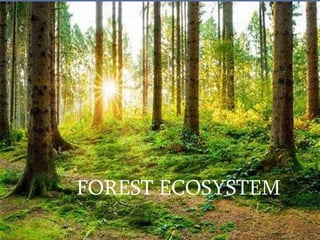The Forest Ecosystem and its Classification
•Als PPTX, PDF herunterladen•
0 gefällt mir•17 views
The forest ecosystem
Melden
Teilen
Melden
Teilen

Empfohlen
Weitere ähnliche Inhalte
Ähnlich wie The Forest Ecosystem and its Classification
Ähnlich wie The Forest Ecosystem and its Classification (20)
Natural vegetation and wildlife PPT for class 9 CBSE

Natural vegetation and wildlife PPT for class 9 CBSE
Salient features of grassland, forest and desert ecosystem

Salient features of grassland, forest and desert ecosystem
Kürzlich hochgeladen
Kürzlich hochgeladen (20)
PATNA CALL GIRLS 8617370543 LOW PRICE ESCORT SERVICE

PATNA CALL GIRLS 8617370543 LOW PRICE ESCORT SERVICE
Call Girls Ahmedabad +917728919243 call me Independent Escort Service

Call Girls Ahmedabad +917728919243 call me Independent Escort Service
Module for Grade 9 for Asynchronous/Distance learning

Module for Grade 9 for Asynchronous/Distance learning
FAIRSpectra - Enabling the FAIRification of Analytical Science

FAIRSpectra - Enabling the FAIRification of Analytical Science
POGONATUM : morphology, anatomy, reproduction etc.

POGONATUM : morphology, anatomy, reproduction etc.
Bhiwandi Bhiwandi ❤CALL GIRL 7870993772 ❤CALL GIRLS ESCORT SERVICE In Bhiwan...

Bhiwandi Bhiwandi ❤CALL GIRL 7870993772 ❤CALL GIRLS ESCORT SERVICE In Bhiwan...
The Forest Ecosystem and its Classification
- 2. FOREST is typically a large area covered mainly with trees and undergrowth. Forests cover one third of the earth's land mass, performing vital functions and supporting the livelihoods of 1.6 billion people. Forests are home to more than half of the world’s land-based species of animals, plants and insects. They also combat climate change and buffer the impacts of storms and floods.
- 3. A forest ecosystem is a natural habitat for plants and animals in a woodland area. It consists of all the living (biotic) and non- living (abiotic) components of the environment that interact with each other. All living (biotic) components can be divided into Producer, Consumer and Decomposer.
- 4. Plants are the primary producers in a forest ecosystem. Producers make their own food. Plants do this through the process of photosynthesis. Many producers also happen to produce, or make, things that animals eat.
- 6. Emergent Layer- This layer is composed of tall trees (70-80 meters max) and is reported to obtain constant sunlight. They’re found only in tropical forests. Forest Canopy- Trees are closely spaced and can be anywhere from 10-25 meters high, but can also be as high as 60 meters. Animals including monkeys, birds, insects, and reptiles inhabit the canopy. Understory- It refers to the plants present just beneath the canopy, and hence, is dimply lit. The majority of the trees are smaller ones (5-10 meters).
- 7. Shrub Layer- The shrub layer is 1-5 meters. They’re rarely found in tropical forests. Some deciduous temperate forests have a rich shrub layer. Non-Woody Herbaceous Ground Cover- In tropical forests, this strata is rarely more than 10% of the forest area. Its mainly just plants and some grasses. Moss, Cryptogam, and Shallow Soil Layer- It includes fallen logs of trees and decomposing litter of fallen leaves and twigs.
- 9. All animals, including mammals, others are called Consumers. Consumers rely on plants and other animals as a food source. Primary Consumers only eat plants and are referred to as Herbivores. Secondary Consumers are referred to as carnivores and feed on Herbivores. Tertiary Consumers is an animal that obtains its nutrition by eating primary and secondary consumers. Omnivores eat both plants and animals.
- 11. Decomposers are any organisms that lives off of ingesting other dead organisms. Decomposers break down dead plants and animals, returning the nutrients to the soil to be made usable by the producers. These include bacteria, ants, termites, earthworms, fungi, etc.